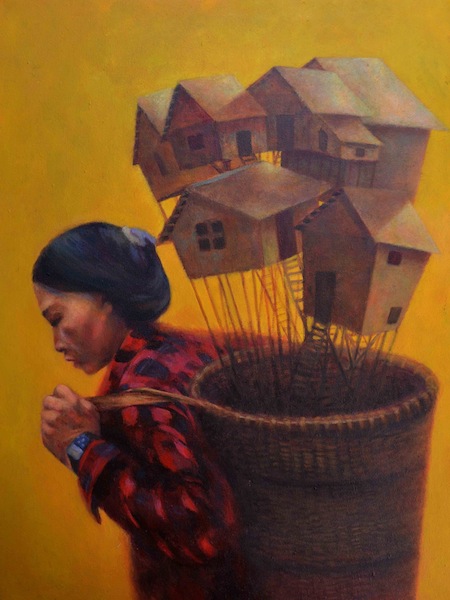A year ago, artists Poy Chhunly and Koeurm Kolab decided to visit Ratanakkiri province to paint hill tribes living in the forests before development and rubber plantations claimed the wilderness and pushed them out.
Upon arriving near the provincial capital, they discovered they were too late.

“It’s filled with concrete houses, vehicles and motorcycles, paved roads and ATM machines,” Mr. Chhunly said.
So instead of the large paintings of forest dwellers in lush surroundings they had first envisioned, their series “Golden Land”—being shown at the Sangker Art Space and Gallery in Battambang City—turned into works featuring one person or object against a plain background to reflect a landscape that has vanished.
“I saw a middle-aged indigenous woman walking down the valley with a big basket on her back,” Mr. Chhunly said. “She looked really lost because she couldn’t find any forest products or leaves as the forest is gone and has been replaced by rubber plantations.”
He painted the woman with her face turned away from the viewer, dressed in a sleeveless top and smoking a small pipe, all brown and beige tones against a golden-brown background.
The hilltribe people they met looked sad and sick, Ms. Kolab said. Most of them said they lost what land they once had to land-grabbing or creditors they could not repay, she said.
“What they used to do for work is now gone,” she said of lives that relied on the forests. One of her paintings shows bees hovering above a mound of golden honey against a yellow-gray background. Ratanakkiri is well-known for the honey its hilltribe people made.
But the province does not provide the shelter and security it once did.
During their trip, the artists found themselves about 10 km from the provincial capital of Banlung where a group of hilltribe people were selling vegetables and banana flowers on the ground.
“It was a shock to see this because it was not far from the provincial town full of motorcycle shops and gold stores, and the indigenous people to whom the hill tribe province used to belong now looked like the newcomers,” Mr. Chhunly said.
Both from Battambang province, Mr. Chhunly and Ms. Kolab, 32 and 28, respectively, studied at the Phare Ponleu Selpak’s visual art school in Battambang City, where Mr. Chhunly launched Phare’s animation studio, 1000 Hands, in the mid-2000s. In 2011, the couple went to study in France, where they specialized in 2D and 3D animation. They have now returned to teach animation at Phare.
The exhibition runs through May 27.